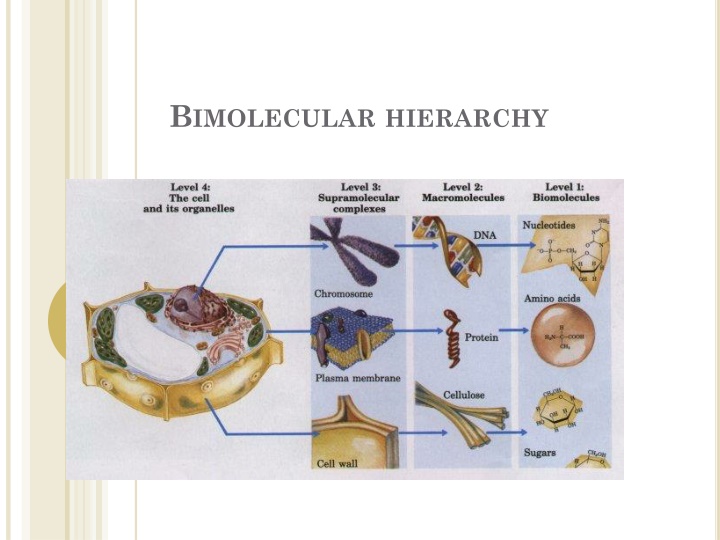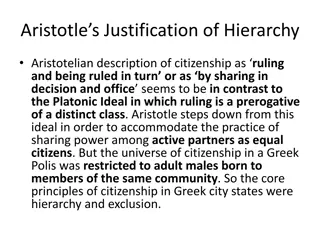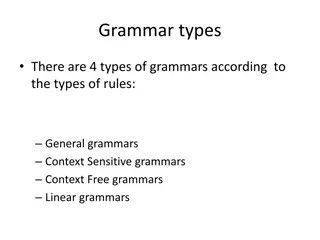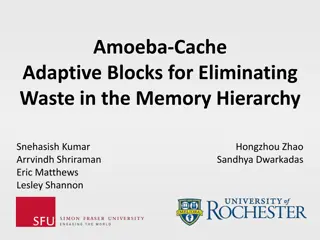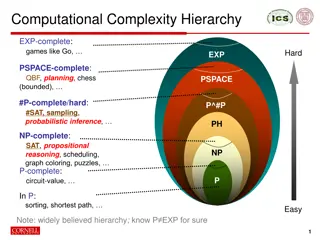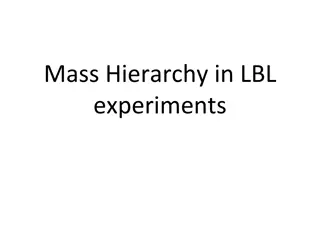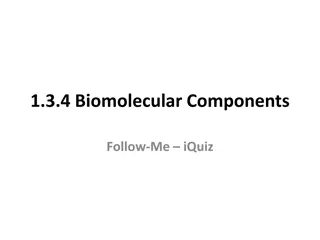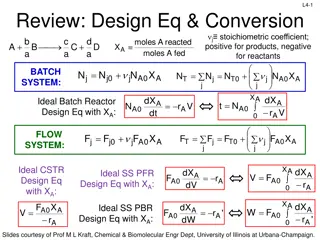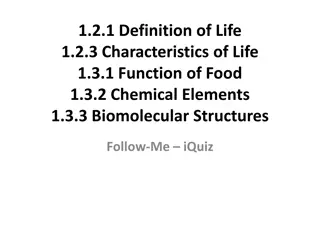Biomolecular Hierarchy
Biomolecules are the fundamental building blocks of living organisms, forming a hierarchy of increasing complexity. From simple precursors to macromolecules and supramolecular complexes, the organization leads to cell organelles and ultimately the complete cell structure. The interplay of different biomolecules shapes the structure and function of cells.
Download Presentation

Please find below an Image/Link to download the presentation.
The content on the website is provided AS IS for your information and personal use only. It may not be sold, licensed, or shared on other websites without obtaining consent from the author.If you encounter any issues during the download, it is possible that the publisher has removed the file from their server.
You are allowed to download the files provided on this website for personal or commercial use, subject to the condition that they are used lawfully. All files are the property of their respective owners.
The content on the website is provided AS IS for your information and personal use only. It may not be sold, licensed, or shared on other websites without obtaining consent from the author.
E N D
Presentation Transcript
Biomolecules Biomolecules: molecules found in living things. -made up of C, H, O, N, etc. -form macromolecules (proteins, fat, carbohydrates, nucleic acids).
The biomolecules of living organisms are ordered into a hierarchy of increasing molecular complexity: All organic biomolecules are derived from simple low Mwt precursors obtained from the environment (e.g CO2, water, and atmospheric nitrogen) These precursors are converted by living matter via sequence of metabolic intermediates into building-block biomolecules (e.g amino acids, nucleotides, glucose, fatty acids)
These building block molecules are then linked to each other covalently to form the macromolecules of the cell. macromolecules (e.g proteins, nucleic acids, polysaccharides, lipids) macromolecules of different classes associate with each other non-covalently to form supramolecular complex supramolecular complex (e.g lipoproteins)
Finally, at the highest level of organization in the hierarchy of cell structure, various supramolecular complexes are further assembled into cell organelles. Cell organelles (e.g nuclei, mitochondria, and chloroplast)
It is clear that the dimension, shape and physical properties of the simple building block biomolecules must determine the dimension and properties of macromolecules whose shape must in turn determine how they fit together to form supramolecular structure, which in turn determine the structure of cell organelles and ultimately of the cell itself.
Cells -Cells are the structural and functional units of all living organisms. -The smallest organisms consist of single cells, whereas larger organisms are multicellular. -Multicellular organisms contain many different types of cells, which vary in size, shape and specialized function. Cells of all kinds share certain structural feature: 1) The plasma membrane 2) Cytoplasm 3) Ribosomes 4) either nucleus or nucleoid
Classes of cells: 1) Prokaryotes: -Cells without nuclear envelopes. -Lack both a true nucleus and organelles. e.g bacterial cells, blue green algae 2) Eukaryotes: -Cells with nuclear envelope -Have a true nucleus and organelles e.g animal, plants,
Eukaryotic cells have a variety of membranous organelles: The organelles in eukaryotic cells: 1) nucleus 2) Endoplasmic reticulum 3) Golgi apparatus 4) mitochondria 5) chloroplast in plants 5) lysosome 6) peroxisome
Macromolecules are the major constituents of cells: -Many biological molecules are macromolecules. Example: major classes of biomolecules in E.coli cell:
-The proteins are the first most abundant macromolecules in the cell, making up over 50% of the dry weight. -The second most abundant set of macromolecules are nucleic acids. - followed by carbohydrates and lipids. -All living cells contain about the same proportion of the major classes of biomolecules as shown in E.coli
The major classes of biomolecules: 1) proteins 2) Carbohydrates 3) Lipids 4) Nucleic acids https://www.youtube.com/watch?v=RQ- SMCmWB1s https://www.youtube.com/watch?v=KF7V e8eM_xk
